The design of the fence includes posts and fillings between them from different materials. Serves as the border of the territory. Horizontal wooden fences can be deaf and with gaps (palisades, solid panel boards and low wicker). Fences are built in the open air, passages are made in them in the form of wickets and gates for the passage of vehicles.
- Basic requirements for a fence made of wood
- Advantages and disadvantages of the design
- Material for building a fence
- Fence
- Reiki
- Planks
- Beams
- Branches
- Wooden pallets
- Croaker
- Installation methods
- Vertical
- Horizontal
- Lattice
- Chess
- Ranch fence
- Herringbone fence
- Jalousie
- Palisade
- Weaving
- Thread
- Combined
- DIY wood fence
- Wood preparation
- Necessary tools for the job
- Construction technology
- Installation of supports
- Assembling the frame
- Fence painting
Basic requirements for a fence made of wood
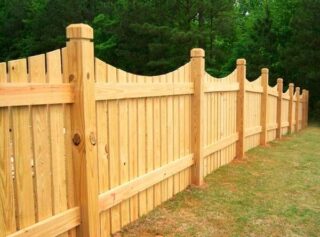
There are technical standards that must be observed in order to mount a reliable and strong village fence or boardwalk in the city or in the country.
List of requirements:
- section length should not be more than 2.5 m;
- the supports are buried in the ground so that the foot of the pillar is below the freezing mark, and the length of the underground part is not less than ¼ of its total length.
The support posts of the wicket should be thicker than the rest of the supports and rise above the upper boundary of the filling by 10 cm.
Advantages and disadvantages of the design
The universal fence fits harmoniously into different landscapes, especially the wood looks beautiful in the garden area. The material is distinguished by its democratic cost and ease of installation. Natural wood looks expensive and has a pleasant color. Failed parts are easily replaced in a wooden fence.
The disadvantage is the short operating time, the need for regular painting. The tree catches fire easily.
Material for building a fence
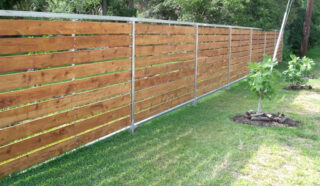
A variety of lumber is produced from tree trunks. They are all great for building fencing.
Fence
The material is horizontal or vertically installed planks, boards. They are placed with empty spaces, fixed on horizontal girders from rails.
The longitudinal beams are supported by vertical pillars made of wood, metal, concrete, stone, which are deepened into the soil. Pickets are placed from the face of the fence or installed on both sides.
Reiki
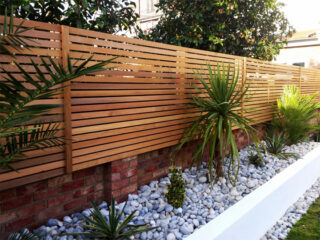
Lumber is marketed with thin wood planks used to make original hedges. A fence made of wooden slats does not have a great strength, more often such fences are placed for decorative decoration of flower beds, lawns.
Fence slats are produced in the size of 20x40 mm, 15x40 mm, 25x50 mm are made. After installation, they are covered with wood stain, varnish in several layers.
Planks
The available material is used for the construction of high and strong fences of private territories. They are placed horizontally and vertically, placed in a continuous layer or allow for gaps for partial viewing of the inner space of the courtyard.
Use unedged and edged material with a thickness of 20 - 40 mm. Any width for a fence from an edged board is taken, but a size of 100 - 150 mm is popular.
Beams
The durable material is distinguished by its thickness exceeding 60 mm.
There are varieties of timber:
- edged;
- glued;
- profiled.
Edged timber is the cheapest, but requires careful treatment with antiseptics before installation.The glued material is impregnated during the production process, gives the least shrinkage compared to profiled and edged ones.
Branches
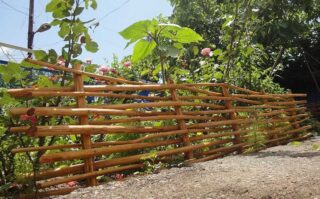
The hedge has a distinct rustic flavor, therefore it is used in the appropriate area. Use hazel branches, vines. Other rocks are considered fragile and unravel at the first strong wind.
Stakes and poles are driven into the ground and a horizontal fence is made of wood, woven with elongated branches. The fence has a short service life; it is installed to delimit sections of the internal space.
Wooden pallets
The budget option from wooden containers is used for zoning the territory, fencing the beds, highlighting individual areas. Pallets are placed entirely or cut in height if a low picket fence is required.
Such products are installed quickly, painted in various colors that are in harmony with the landscape. They take new packaging elements or use old ones. Vases and flower pots are used in the decoration.
Croaker
The material represents the longitudinal waste of the trunks when cutting the rounded logs. The ends of the products differ in width and thickness; the characteristics of the thin end are used for classification. On the slab, one sawn and the other untreated convex side is obtained.
The fence has an original look, the elements are installed side by side, mounted on both sides, decorative gaps are made.
Installation methods
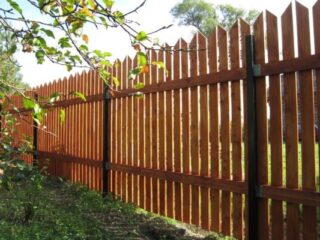
Conifers are used, since they absorb less moisture due to the content of resinous substances. Larch is used because the wood does not deteriorate from contact with water. Powerful fences of country houses are made from such a tree. Birch belongs to the budget option with a beautiful structure, oak, cedar are not used due to the high cost.
Vertical
Pickets, bars, boards are fixed on the longitudinal beams between the posts. There are usually two runs - one at the bottom, the other at the top of the fence. The elements are mounted with gaps, or they are placed in a solid, it all depends on the idea and functional purpose.
Horizontal
The lumber is supported on vertical racks, which are placed at intervals of 1 - 1.2 m from each other. These can be full-fledged pillars dug into the ground or small vertical elements that play a decorative role.
Lattice
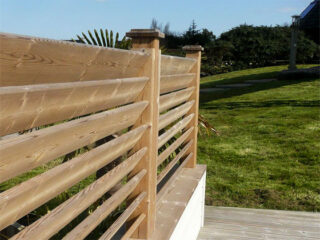
Thin slats, planks are used, they are placed with a cross to each other. Elongated parts are placed perpendicularly and parallel to the ground; in another version, the elements are fixed at an angle. It turns out a rectangular or oblique lattice.
The slats are placed on the front side, overlapped or butt-connected. There is an option of installing strips from two sides of the intake panel.
Chess
Longitudinal girders of boards, slats, timber are attached between the posts. The finishing details are fixed alternately from the outer and inner sides of the fence. It turns out a volumetric fence, in which the strips alternate in a checkerboard pattern, following one after the other.
The structure turns out to be almost opaque, while the consumption of wood increases. The surface is varnished or painted with oil compounds for outdoor use.
Ranch fence
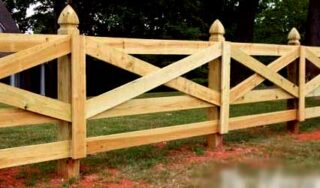
The minimum volume of wood is used for such a fence. Two longitudinal strips are stretched between the posts, slats, slabs, bars are used. As a rule, they are made as a fence for livestock, sometimes they are used for zoning the area of a large yard.
The gaps are closed with a metal mesh so that animals do not crawl between the slats. The decorative version provides for the coloring of the elements.
Herringbone fence
This order is a kind of horizontal mounting method. The planks are not placed vertically, but so that the upper board forms an overlap on the lower one. It turns out the silhouette of a Christmas tree, if you look at the structure from the side.
The coating is classified as opaque and is used for the construction of a solid fence. Boards are finished with wood stain, varnished or painted, combined with forging.
Jalousie
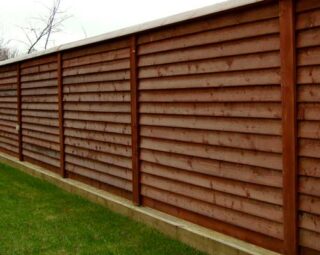
The variation is similar to the previous mounting order, but there are differences. Boards are also placed horizontally at an angle, but between them leave gaps for ventilation or street view. The fence is suitable for yards with a swimming pool, artificial lake.
Palisade
Many vertical pickets, slats or narrow boards are placed close to each other so that they form a single cover without gaps. The result is a massive and durable structure, which can be of different heights.
The tops of the lumber are sharpened, as a result, they take on the appearance of stakes. Used for stylized enclosures in landscapes. Usually such fences are not painted, but only varnished.
Weaving
It resembles a wicker, tree branches or thin boards, slats are used as a material. It is easier to bend the branches, but lumber is also passed from one side or the other of the rack, and the overlying slats are installed in the opposite order.
Usually the planks are placed horizontally, but there are also vertical options, then a more voluminous fence with a high wood consumption is obtained.
Thread
They use carved boards, obtaining a unique design of the site. Such a fence is combined with wooden, stone buildings, and adds elegance to the territory of the courtyard. You can do the carving yourself.
The lacquered fence emphasizes the naturalness of the material, while the white painted fence creates a solemn and festive look.
Combined
Combinations of different installation methods are selected so that the fence looks organic and does not turn out to be a pile of styles. Sometimes the inside is made with a mesh, and a herringbone is used outside, blinds are installed. Then the squares on both sides look original and give pleasure to the owner.
They use alternation in color, use a checkerboard, but the details are highlighted not by location, but by color. For example, black and white elements alternate.
DIY wood fence
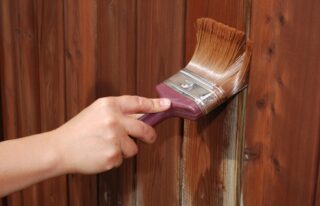
First, they prepare the construction site, mark the location of the pillars. Measure the perimeter, count the amount of material. They outline the location of the gate, wicket with pegs and a cord.
Wood preparation
Impregnations penetrate the wood structure and form protective layers on the surface against fire and moisture absorption. Means protect against damage by bugs, the appearance of mold.
Processing is done before installation, but during the service, the fence is also periodically painted and varnished to renew protection. The interval between painting is 2 - 3 years.
Necessary tools for the job
Bayonet shovels are needed to dig holes for columnar supports. Dense and stony soil will require the use of scrap; in overgrown areas, the roots of bushes in the soil are chopped with an ax.
The wood is processed with a plane, emery. For sawing, use a hand saw or an electric jigsaw. Metal supports are cut with a grinder, connected by welding. The boards are fixed to the supports with a screwdriver, a drill is used.
They mark the wood with a tape measure, put the marks with a pencil. Coordinate the vertical and horizontal with a level, a plumb line, check the rectangularity with a square.
Construction technology
Allocate the construction of a fence with or without a foundation. In the first case, a trench is dug along the perimeter of the fence, crushed stone is added, then concreted. A support is needed if the fence made of boards is massive, high, thick boards, beams are used.
Without a foundation is a conditional concept, since the foundation is made for separate pillars with filling, reinforcement and concreting.
Installation of supports

The installation method is selected depending on the material of manufacture.Brick supports are placed on top of the foundation base, metal posts are embedded in concrete. Wooden supports are also concreted in pits, while the underground part is wrapped with a layer of roofing material on mastic to prevent the pillar from rotting.
Assembling the frame
The sections between the pillars are mounted in accordance with the chosen technique. Horizontal beams are often installed initially to support the vertical elements. For longitudinal beams, wood and metal are used.
The crossbeams are attached to brick and concrete pillars by means of embedded parts. Connect the pickets to the beam with nails, screws, bolts.
Fence painting
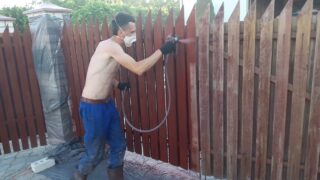
Treatment with paints and varnishes gives the fence made of wood a finished look, prolongs the life of the fence. They use oil paints, enamel paints; they also use silicate, water-dispersion, and silicone paints.
Before painting, the surface is sanded with sandpaper, achieving perfect smoothness. After that, the surface is primed with a composition that is suitable for the selected type of paint. The varnished surfaces are sanded again after the first layer has dried, since the varnish lifts the wood fibers, they must be removed.








